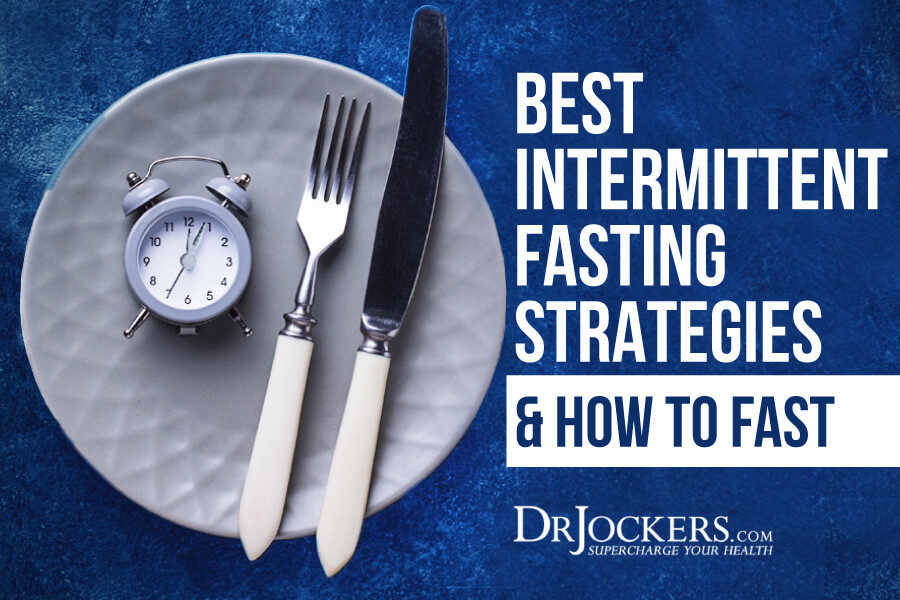 What are the Best Intermittent Fasting Strategies?
What are the Best Intermittent Fasting Strategies?
Fasting is a practice that has been employed for thousands of years for religious and health reasons. It is simply the practice of not consuming food for a period of time, opting instead for nothing or at least non-caloric beverages like water and herbal teas. Evidence continues to pile on for the benefits of fasting and a particular style of fasting, called intermittent fasting. In this article, I am going to outline different intermittent fasting strategies and explain how to best incorporate them into your life.
If you have never tried fasting before, no worries, getting started is simple and fairly easy for most people. It is something I have my coaching clients do as a foundational healing and performance strategy on a daily basis.
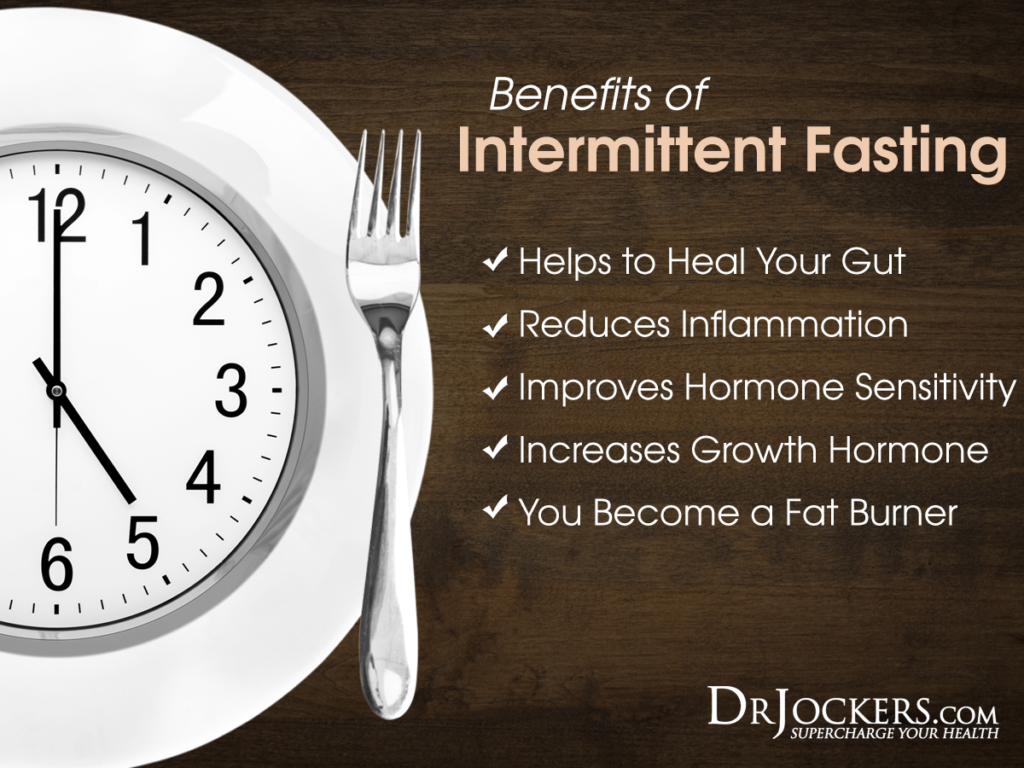
Benefits of Fasting
Fasting comes in many different forms which we will discuss in a moment. The benefits of fasting are quite extensive and may even be amplified in conjunction with a ketogenic lifestyle, which you can read about here: Keto Metabolic Makeover
For everything from a cognitive boost, to protection from a whole range of chronic diseases, fasting has many applications. The following are some of the most profound.
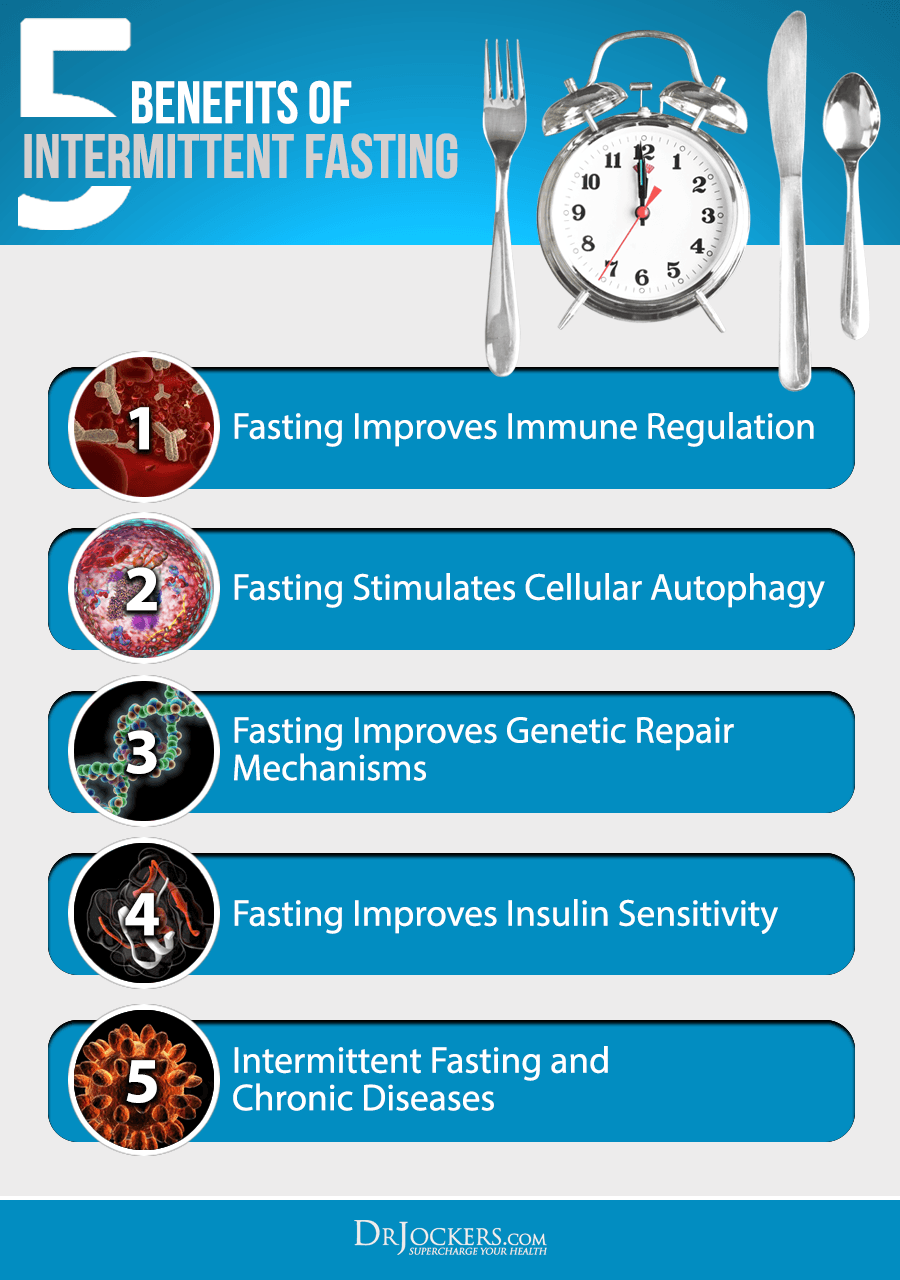
Stronger Immune System
Using intermittent fasting strategies can be a powerful way to boost the immune system. One way that this happens is by boosting the function of neutrophils in the body. Neutrophils are the most abundant white blood cell in humans. They play a vital role in neutralizing infections and controlling inflammatory responses in the body.
Having too high or too low neutrophil counts is commonly associated with things like heart disease, cancer, Alzheimer’s, rheumatoid arthritis, depression, irritable bowel syndrome, chronic fatigue, and certain autoimmune diseases.
Neutrophils neutralize pathogens by engulfing and destroying them. Several studies have shown that when certain types of sugar are consumed, neutrophils will tend to engulf sugars, detracting from fighting pathogens (1).
Several studies have also shown that intermittent fasting has a positive impact on the gut microbiome, favoring the growth of beneficial microbes over harmful ones such as salmonella (2). The balance of bacteria in our gut plays a crucial role in determining the strength of the immune system.

Cellular Autophagy
Autophagy is the process in which the body breaks down old, weakened and damaged components of cells, and recycles them for energy. In doing so they make room and stimulate the production of new and more efficient cells.
This process also assists the immune system in controlling viral and intracellular parasite replication, common sources of chronic inflammation. Chronic inflammatory conditions underlie most modern-day diseases such as metabolic disease, heart disease, cancer, and autoimmunity.
Fasting is a powerful way of upregulating cellular autophagy for the benefits mentioned above. These benefits are especially healing for the brain as they help to protect it from abnormal growths, toxins, and other sources of inflammation (3).
Autophagy benefits are primarily gained during longer fasting cycles of 16 or more hours. I am going to explain how to achieve these benefits by combining longer and shorter fasting cycles later in this article.
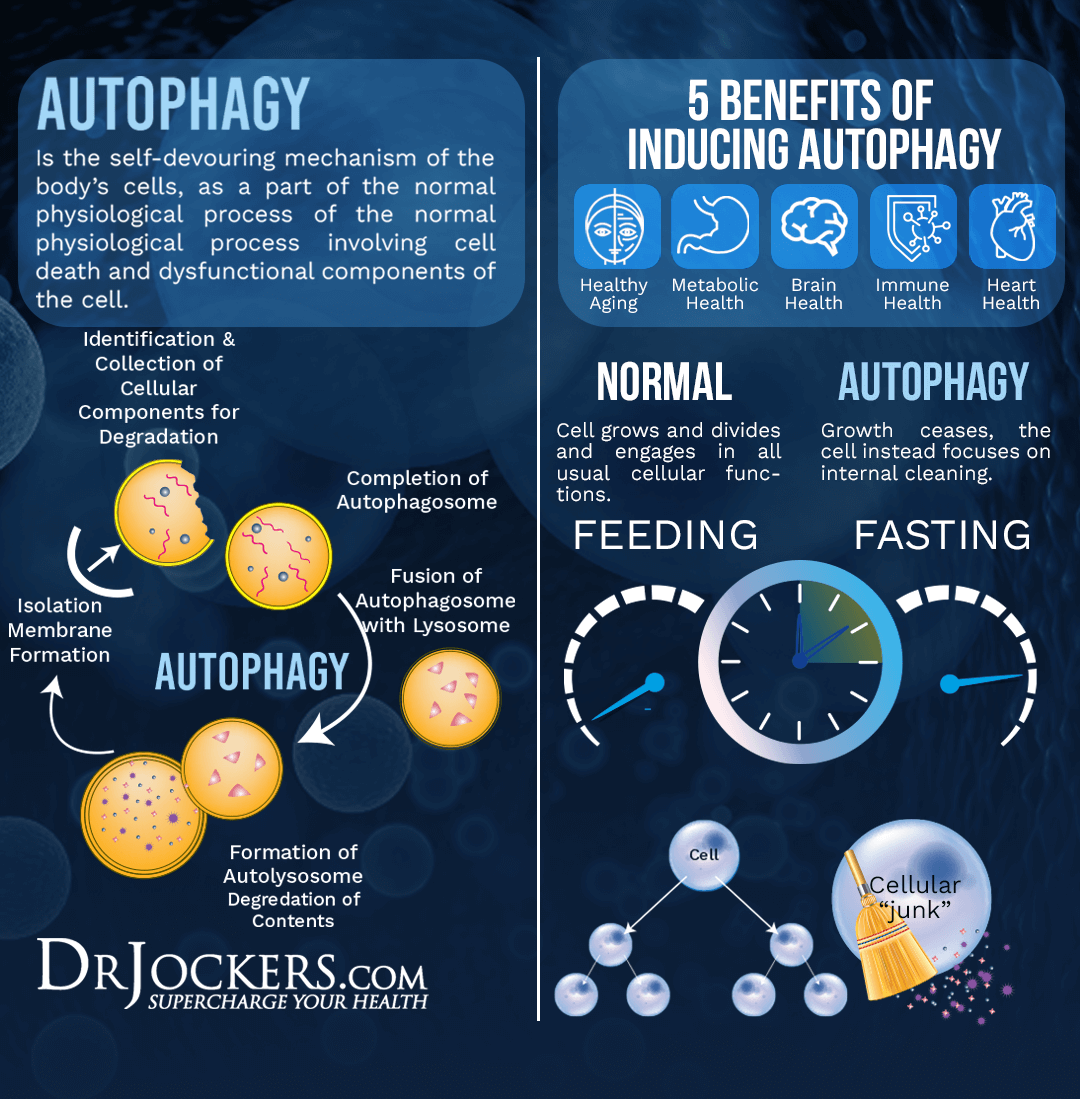
Improved Genetic Repair
Animal studies have shown that employing intermittent fasting strategies may increase lifespan by up to 30% (4). More longitudinal human studies will be needed to confirm this benefit, but considering its other benefits, it is plausible.
Other studies have shown that intermittent fasting boosts the body’s resilience to stress and alters biological pathways in a way that positively impacts lifespan (5, 6). Finally, these benefits extend to the brain to protect from neurodegenerative disorders both by protecting neurons and reducing inflammation within the brain tissues (7). This adds both years and quality of living to your lifespan.
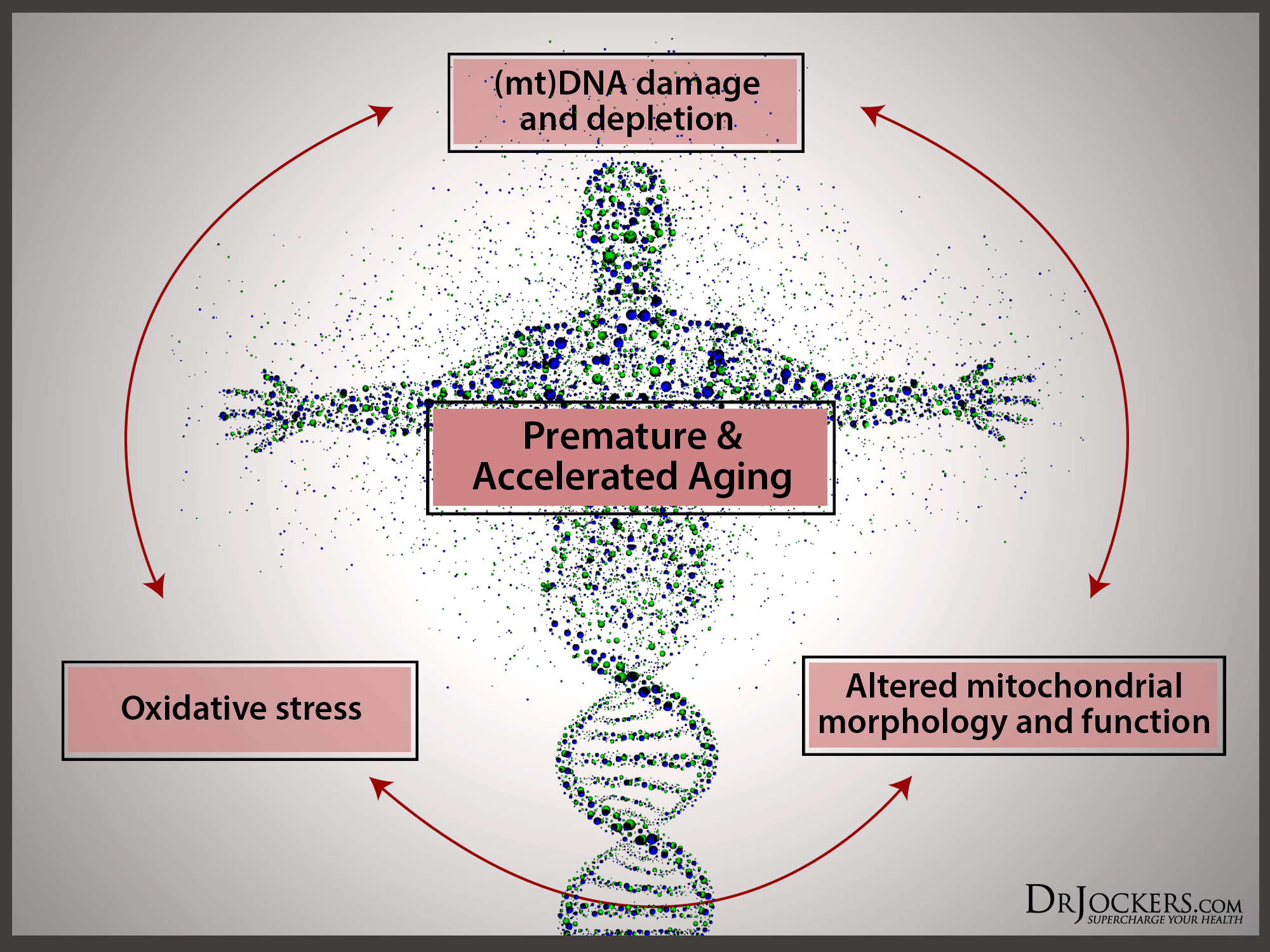
Improved Insulin Sensitivity
Most people today are heavily reliant on sources of carbohydrates to meet their daily energy needs. Based on experience and data available, carbohydrates are not an ideal energy source. It appears our bodies adapted to endure and thrive during times of scarcity where fat burning overrides carbohydrate metabolism and many beneficial processes take place.
Our heavy reliance on carbs has resulted in a massive increase in metabolic disorders which include insulin resistance and diabetes.
Incorporating intermittent fasting strategies can help to restore insulin sensitivity and stabilize blood sugar which has been showcased in a number of research studies (8). Ultimately, this improves the body’s ability to burn fat as an energy source and use carbohydrates more efficiently when they are consumed.
This is why combining intermittent fasting with a well-designed ketogenic diet is one of my go-to strategies for helping someone regain their health and vitality.
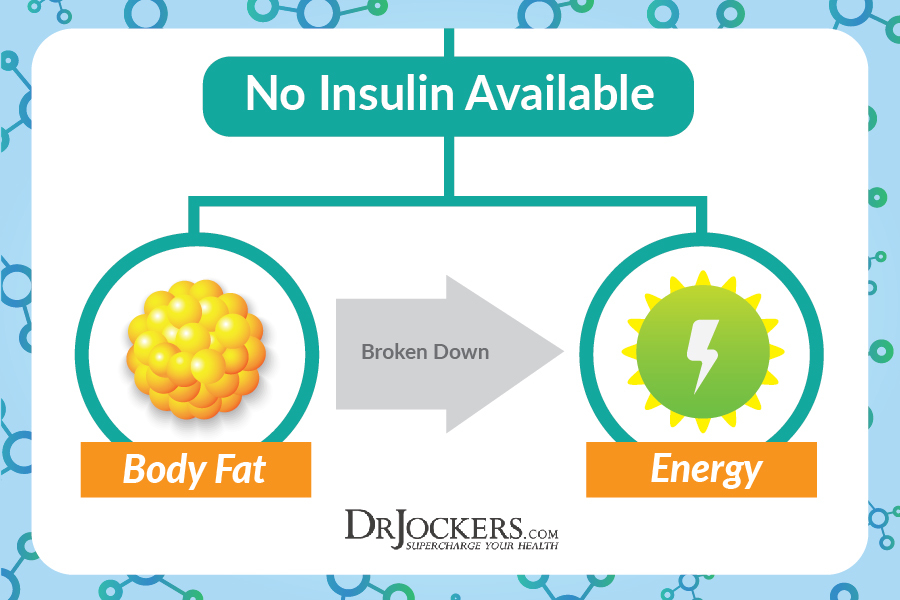
Reduced Risk of Chronic Diseases
Intermittent fasting improves metabolic flexibility, immunity, and lowers inflammation throughout the body. Additionally, it stimulates the production of more efficient mitochondria. These benefits combined lower your risk of many diseases that are prominent today.
There is a vast array of evidence showcasing that intermittent fasting strategies improve cardiovascular health, help to balance cholesterol and triglyceride levels, lower blood pressure, and may protect you from certain types of cancer by modulating the IGF-1 pathway (9).
Other conditions that have been identified to benefit from intermittent fasting include; chronic inflammation, obesity, irritable bowel syndrome, rheumatoid arthritis, asthma, and certain inflammatory skin conditions such as acne and eczema.
As if that wasn’t enough, intermittent fasting has been shown in many cases to help with mood disorders such as anxiety and depression. While not a treatment on its own, it may play a critical role in a holistic lifestyle geared around optimizing neurological function.
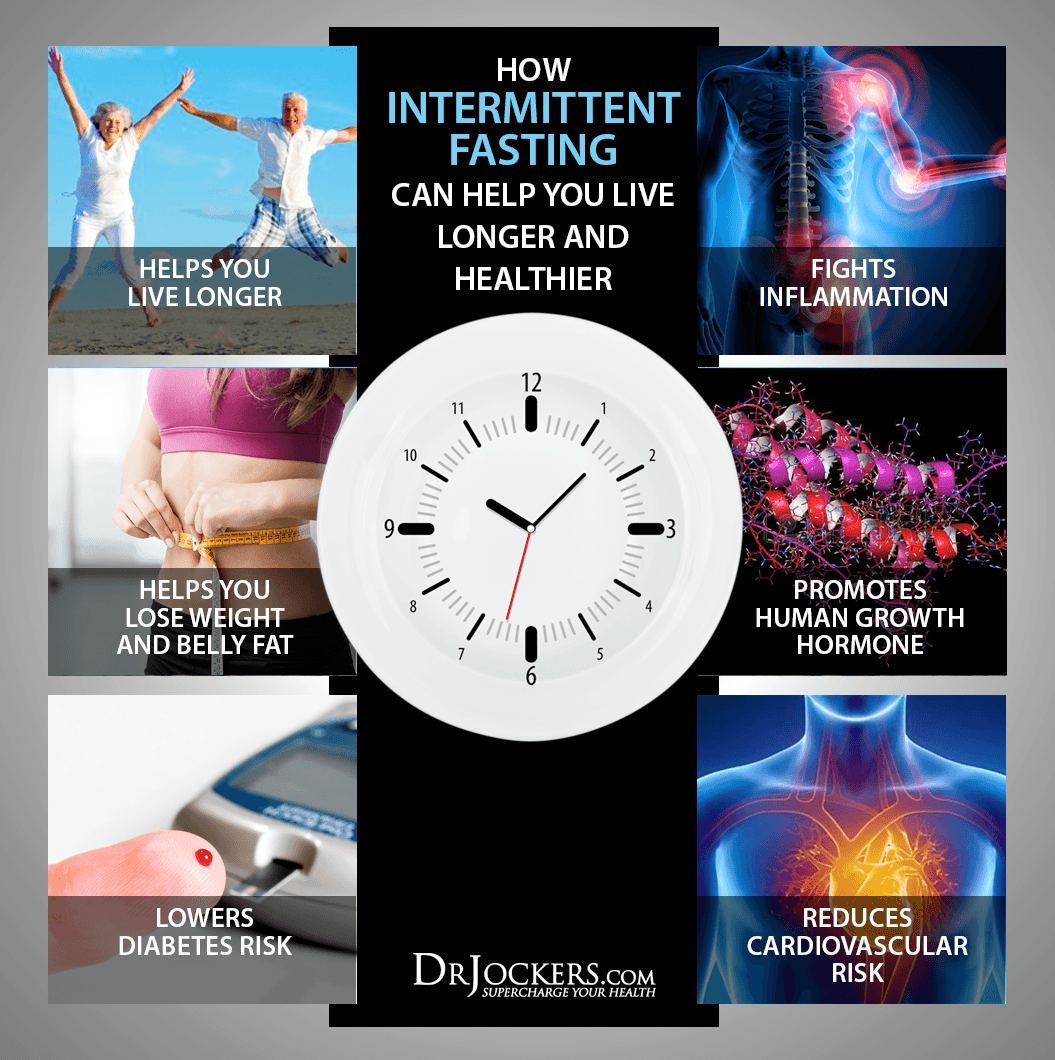
Intermittent Fasting Strategies
Intermittent Fasting Strategies come in all different variations. For daily lifestyle, I usually recommend one of the strategies outlined below. Keep in mind that when you first begin, it is best to start with a shorter fast and build your way up as your body adapts to not eating at certain times of the day.
Beginning with the simple fast for 1-2 weeks, seeing how your body responds, and scaling up or down from there is a great way to approach these intermittent fasting.

Simple Fast
A simple fast is the shortest duration intermittent fasting strategy and is best for beginners. This is where you fast for 12 hours which includes your sleep period overnight. This will help your body open up its drainage pathways by allowing the liver to cleanse the bloodstream, taking stress off of the gut and helping the body to burn fat.
Example: If you finish eating dinner at 6PM on Monday night, you will not eat again until 6AM the following morning.
After trying out a simple fast for 1-2 weeks, you can extend this to 14 hours and try that for 1-2 weeks. The 14 hour fast we call a brunch fast! The next step up would be to a Crescendo fast and you can read all about the benefits of that here

Cycle Fast
A cycle fast is a step up from a simple fast. This is where you extend the 12-14 hour fasting window to a 16-hour fasting window. The difference here is that this fast is only performed 3 times per week.
Example: If you finish eating dinner at 6PM on Sunday night, you would not eat again until 10AM Monday morning. On Tuesday, you would eat on a normal schedule and wait 16 hours after dinner to eat your first meal Wednesday morning. You would repeat this again Thursday into Friday. So, your fasting days would be Monday, Wednesday, and Friday.
While this approach may seem like it requires a little more planning, it may be a helpful stepping stone towards more advanced intermittent fasting strategies. Alternatively, you could continue the trend with the simple fast, adding an additional hour of fasting every 1-2 weeks until you reach the next strategy, the strong fast.
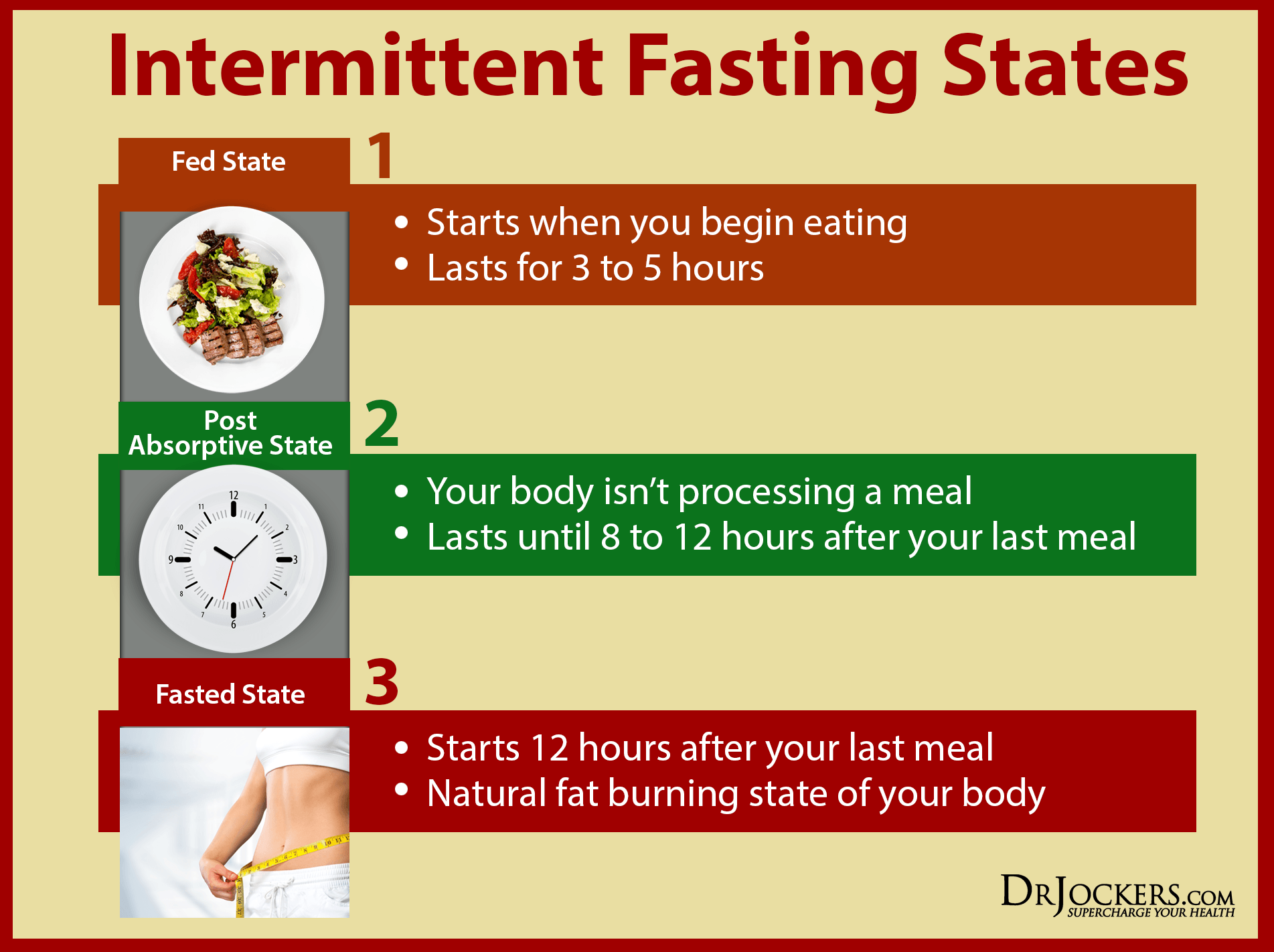
Strong Fast
A strong fast is an extension of a simple fast of 16-18 hours on a daily basis. It is more suitable for those who have attained a high level of metabolic flexibility through previous intermittent fasting strategies or a ketogenic diet.
Example: If you finish dinner at 6PM Sunday night, you would wait to eat your next meal between 10-noon the following day.
This is the sweet spot that most people find that they achieve their highest level of benefits in terms of health and performance. If you are someone who is struggling with some kind of health issue or want to maximize your vitality, this is a great target to aim for.
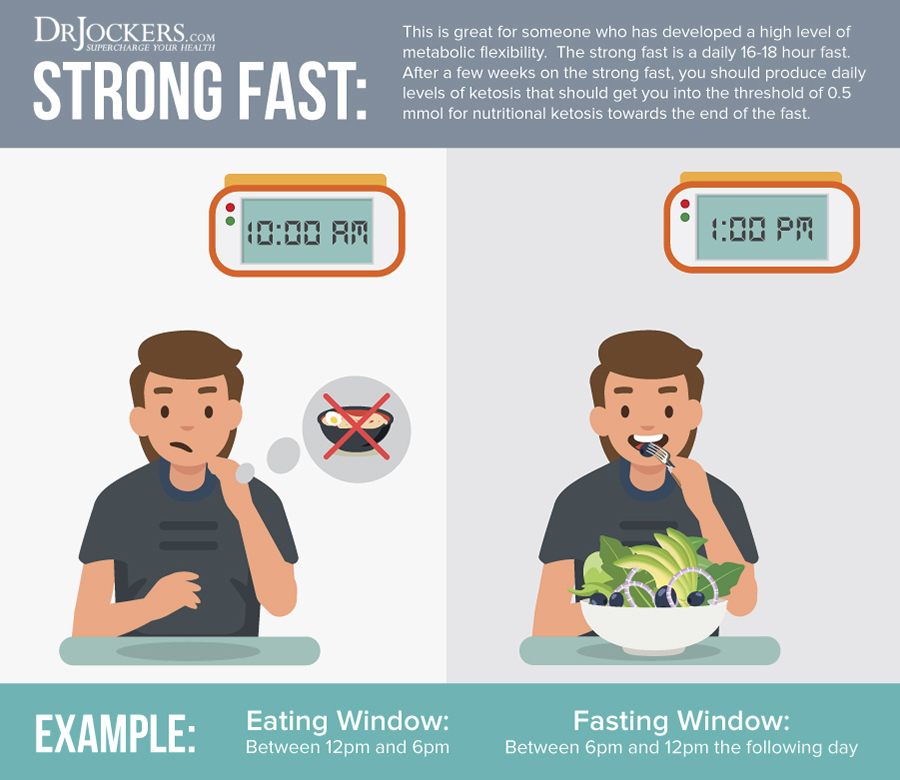
Warrior Fast
The warrior fast is the most advanced intermittent fasting strategy. This is where the fasting window is extended to 19-21 hours per day. This is definitely not for everyone but seems to provide those who can handle it with extensive benefits.
Example: If you finish dinner at 6PM Sunday night, you would wait to eat your next meal between 1-3 PM the following day. This leaves you with a 3-5 hour window to meet your daily caloric needs.
Another way to approach the warrior fast that supports ketosis and fat-burning is to consume a source of fat during the fasting window. In a traditional sense, this is not technically a fast, yet it still provides many of the same benefits. This is now commonly referred to as a fat fast.
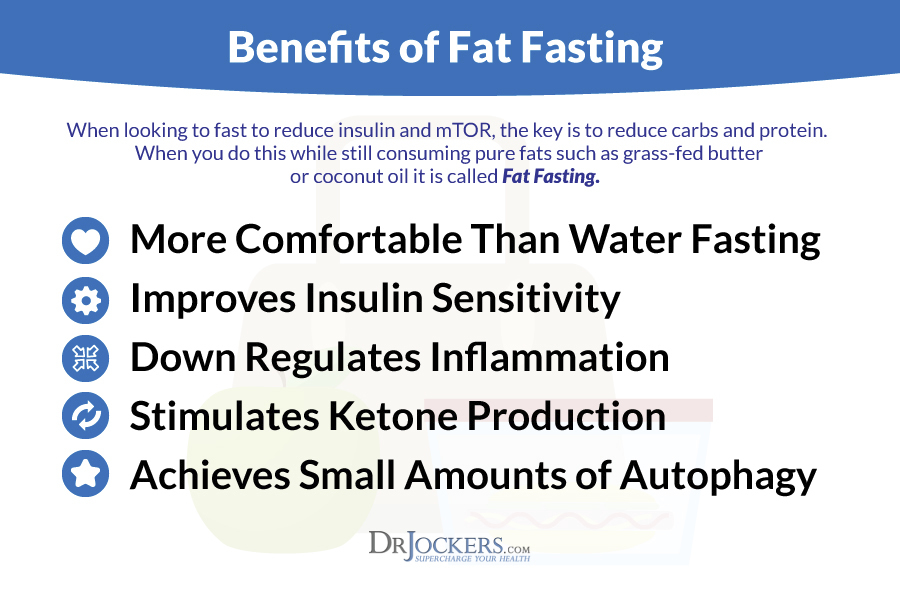
Fat Fasting
Fat fasting is meant to be used as a way of supporting ketosis and energy levels during an extended fast, such as a warrior fast.
Example: Instead of a solid meal containing protein, fats, and carbs in the morning, you consume some kind of meal that only contains healthy fats. Something like a Turmeric Fat Burning Coffee or a Keto Matcha Green tea are excellent for this purpose.
Combining the caffeine with a source of healthy fats helps the person fasting get into a state of ketosis and avoid any hunger pangs that might occur during the fasting window.
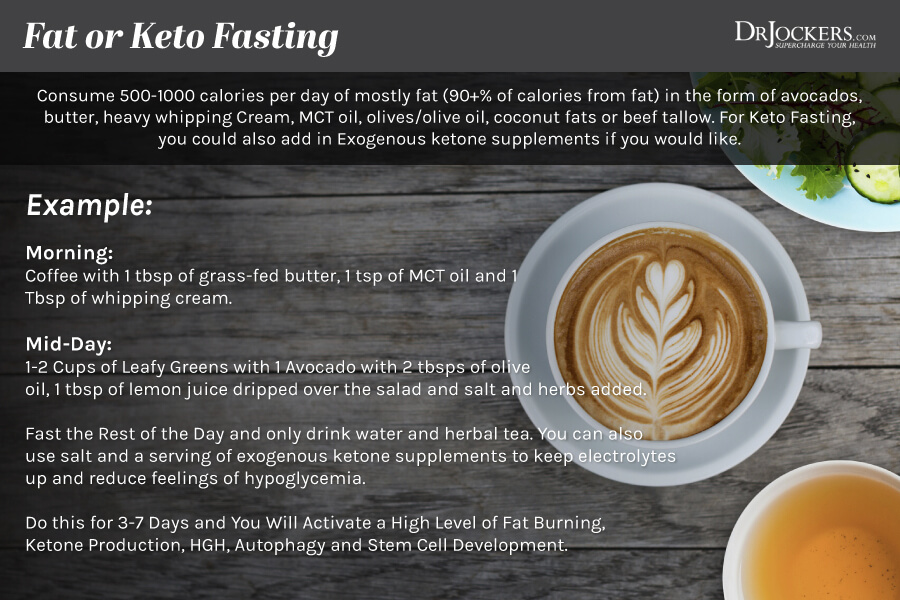
Weekly Intermittent Fasting Strategies
Now that we’ve discussed daily intermittent fasting strategies, it is time to see how they would be implemented on a weekly basis. There are certain ways that I have found to work very well to obtain the benefits of both intermittent and longer styles of fasting.
As I mentioned previously, longer fasts are required to achieve things like autophagy to an extent to provide associated health benefits. Certain weekly strategies can be used to achieve these benefits without fasting for 16 hours everyday.
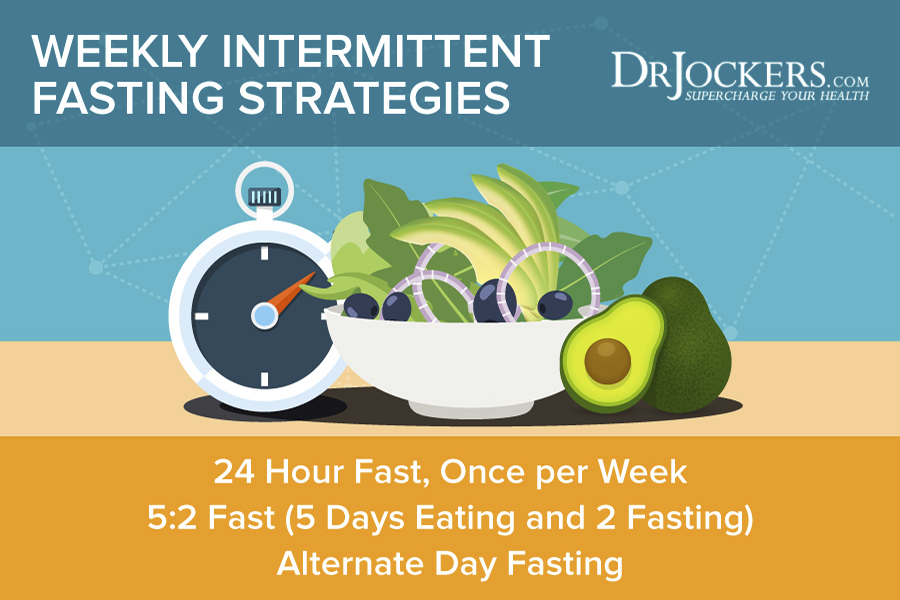
24 Hours, Once per week
A 24-hour fast performed once per week is one of the most practical intermittent fasting strategies as it allows you to choose your most convenient day without altering your entire weeks schedule.
Performing one, 24-hour fast per week is a great way to gain the benefits of autophagy while maintaining shorter fasting windows on a daily basis. In fact, this is something I personally practice and recommend to most people. While not everyone can tolerate a daily 16 hour fast, most people do very well with 24-hour fast once per week.
Typically, it is best to perform this on a day when demands are low. For example, fasting from Saturday night to Sunday night seems to work very well for most people.
One of my favorite combination strategies is combining daily intermittent fasting, one 24-hour fast, and a cyclic ketogenic diet.
Put into action, a typical week would consist of ketogenic meals and intermittent fasting on Monday through Friday, a higher carb “refeed” day on Saturday, and a 24 hour fast from Saturday night to Sunday night at your preferred dinner time.
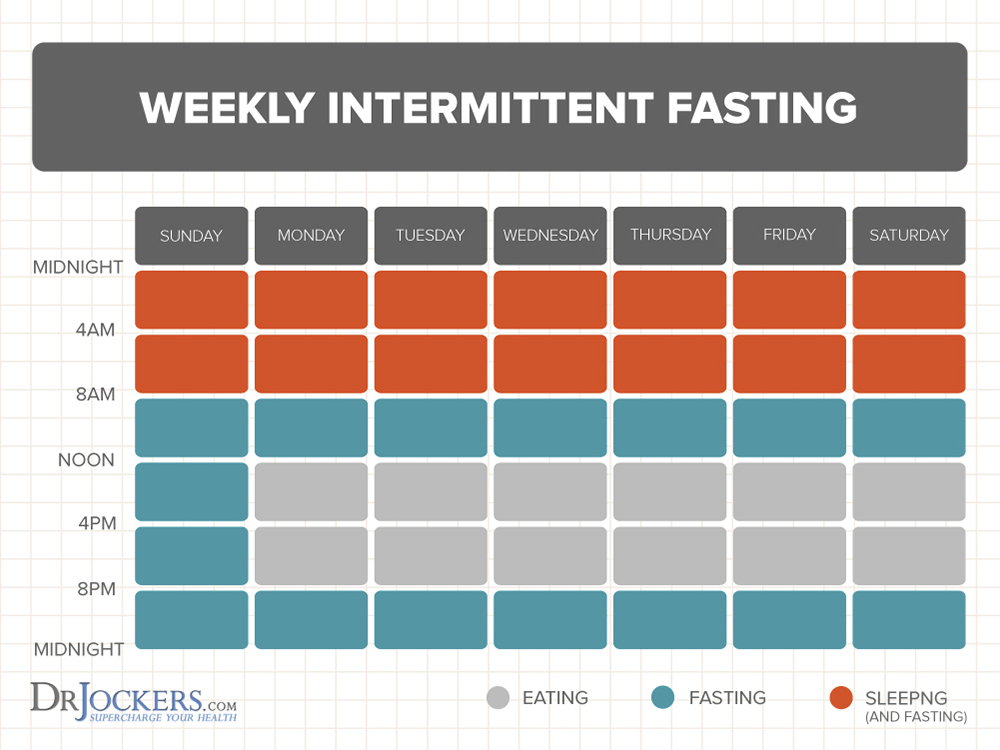
5:2 Fast
Another popular fasting strategy is more of what is considered a “modified” fast. The 5:2 weekly fast is where you choose 2 days out of the week to consume 500 calories or less, with the rest being normal eating days. It is typically recommended that the calorie restricted days are separated by at least one normal eating day.
This specific fasting strategy has been researched and found to provide improvements in insulin sensitivity as well as a reduction in body fat (10).

Alternate Day Fasting
Alternate day fasting is what it sounds like. One day you eat, the next day you fast. On fasting days, you restrict eating to one meal after a roughly 22-24 hour fasting window. If your goal is weight loss, you can restrict your calories to 500-1000 in that one meal. If you aren’t trying to lose weight, than you can eat a very large meal until you are satiated.
This fasting style has become more popular of recent and people are seeing fantastic results with improved insulin sensitivity, weight loss and more. Studies have shown that alternate day fasting may be helpful for boosting endurance exercise performance, reduced cravings due to a feeling of satiety, and aiding in weight loss (11, 12).
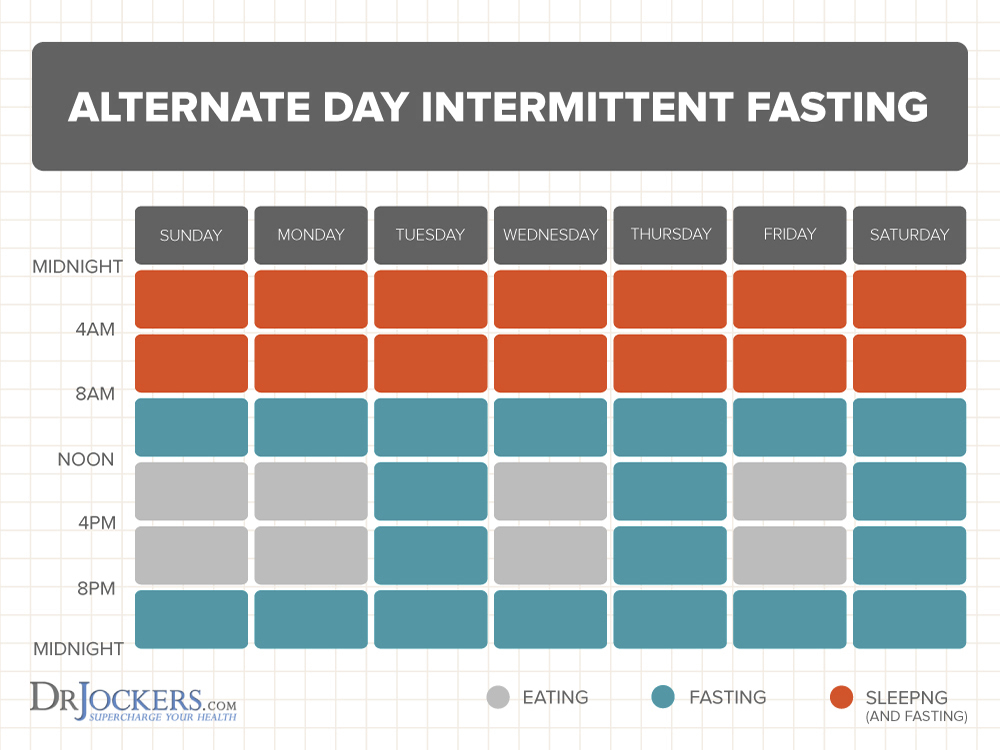
Extended Fasting
Some research has shown that fasting for 5 days per month for three months in a row may promote improvements in cellular regeneration and decreases in risk factors for diabetes, cancer, and heart disease. It also seems to provide an anti-aging effect (13).
Prolonged fasting can be especially beneficial for those with cancer, metabolic diseases, gastrointestinal disorders, and autoimmunity.
I would consider anything from 48 hours and beyond as an extended fast. 3-5 days is a common fasting period that people find a lot of success with that is relatively safe for most people. During this time, you would want to make sure your stress levels remain low, you are replenishing vital minerals using salt or a trace mineral supplement, and closely monitoring yourself for any negative effects.
Some people have achieved great success performing water fasts longer than 5 days. This is something you would absolutely want to consult with your doctor about. There are fasting center located around the world that specialize in supervising extended fasts. Although this is easily one of the most advanced intermittent fasting strategies, doing this 1-3 times during the year can provide many benefits if done properly.

Breaking an Extended Fast
When you go on an extended fast, a number of changes occur in the body. One of these things that is important to consider is that the digestive system completely shuts down. If you break your extended fast with a large meal, it can be quite stressful on the body.
Breaking an extended fast should be gentle and gradual. The following is what I would recommend following a 3-5 day (or longer) fast:
- Consume only broths, soups, and fermented drinks for the first 1-3 days after breaking your fast. Bone broth can be especially great for providing lots of gut healing nutrients to support the important mucosal barrier.
- For another 1-3 days, consume low-carb smoothies and light meals
- Finally, begin to incorporate more solid food meals including healthy fats, lightly cooked vegetables, and small amounts of clean protein
While it is pretty straight forward, it can be tempting to break an extended fast with a massive meal full of all your favorite foods. Resist this temptation, your body will thank you!
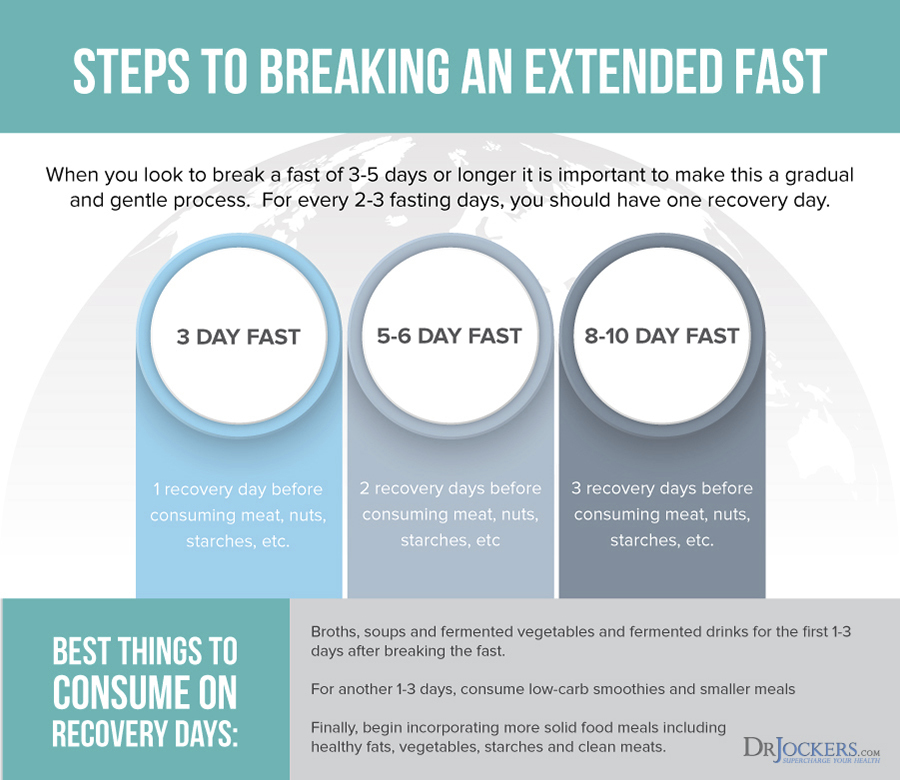
Common Challenges
Most people will benefit greatly from reducing their carbohydrate intake and shifting over to a high-fat, low-carb nutrition plan. Making the initial shift, however, many people struggle with cravings and energy instability. This is primarily due to blood sugar imbalance and a number of things can be helpful for this.
Supporting blood sugar balance will be a key component of successfully implementing intermittent fasting strategies. The following graphic outlines some of the best ways to stabilize blood sugar and reduce these cravings. You can read more about these strategies here: 7 Ways to Stop Sugar Cravings
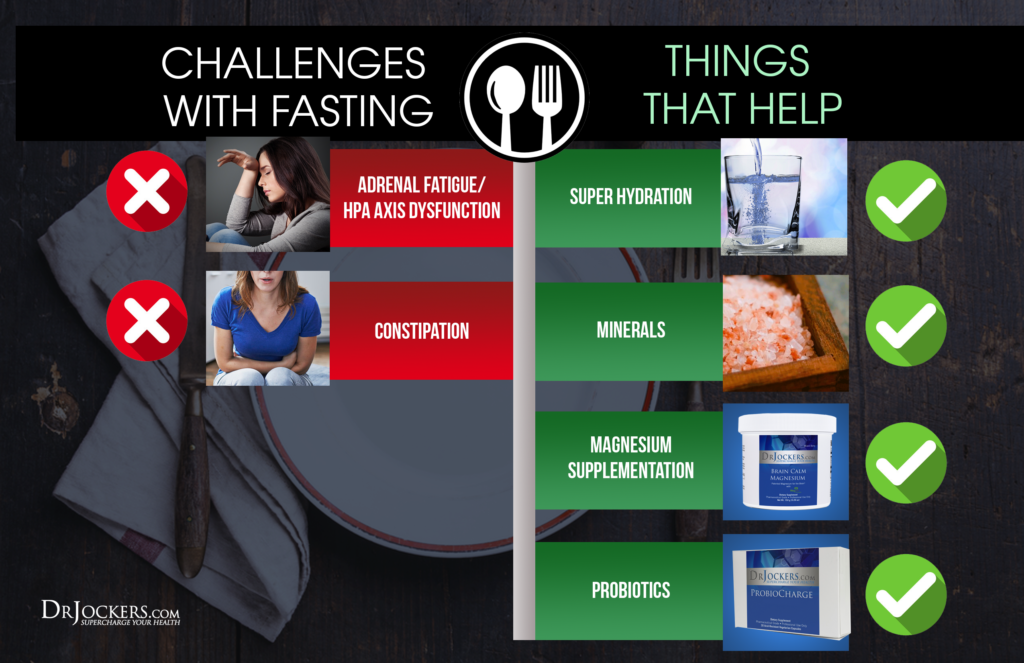
Adrenal Fatigue/HPA Axis Dysfunction
Those dealing with adrenal issues will have a hard time adapting to fasting. For these individuals it is recommended to really focus on hydrating well and using electrolyte minerals as much as possible to assist in energy production.
Additionally, focusing on deep breathing exercises, performing grounding daily in the sunlight, and controlling stress will all be important for helping your body derive benefits of intermittent fasting. These individuals will also want to start with a 12-hour fasting window for an extended window (a month or more) before progressing to longer fasting windows.
We also find that taking magnesium can be really helpful for improving adrenal health and supporting the bodies ability to effectively carry out a fast.

Constipation
If your bowels are not moving while you are fasting, this could be harmful to the body and inhibit some of the benefits. Constipation will allow waste to build up and putrefy in the colon, creating toxic waste products that transfer into the blood stream creating inflammation and inhibit brain function.
To avoid this, there are a number of strategies you can use to keep your bowels moving:
- Drink plenty of water with a pinch of salt
- Use magnesium supplementation
- Consume plenty of prebiotic fibers such as avocado, garlic, onions, green leafy veggies and/or cruciferous veggies with meals
- Use herbal teas and other herbs, like aloe vera, to assist with healthy elimination
- Use probiotics to support the microbiome and improve bowel dynamics
The Fasting Transformation Book
I am super excited to introduce you to the book I have spent the past 18 months putting together. It goes into the most recent scientific research and strategies for implementing intermittent and extended fasting into your life.
I could not be happier with the content in this book that you can review here. It is by far the best book on fasting the world has ever seen and I have read them all! It is now, my great honor to present this to you and I am deeply appreciative of your support!
Summary
The benefits of using intermittent fasting strategies are profound. Now you have the foundation to begin incorporating these strategies into your daily life to help reach your health goals.
Start with a simple fast and work your way up. If you want to take these benefits to the next level, I recommend using fasting in conjunction with a ketogenic lifestyle to optimize mitochondrial function and improve health and performance in many different aspects of your life.

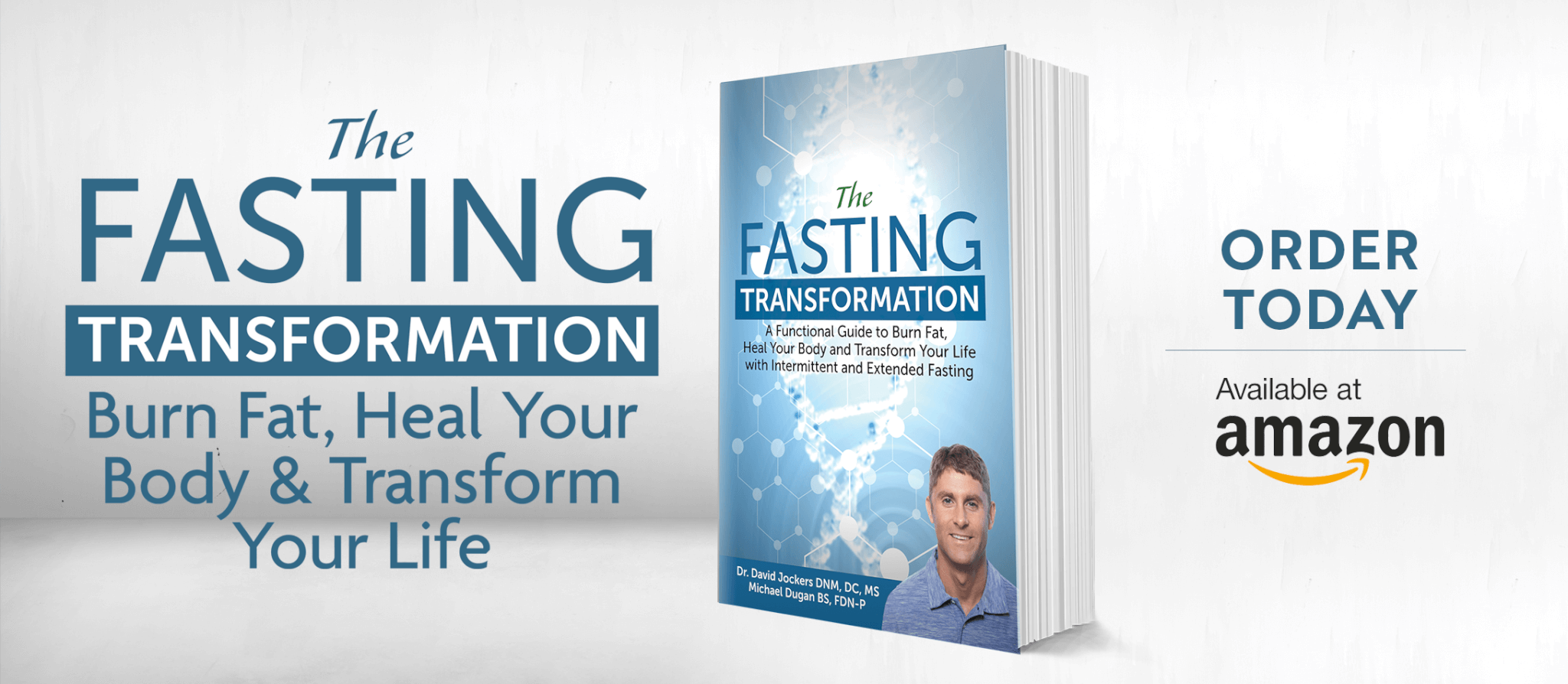



If I want to restrict my eating to noon – 8pm, would having my morning cup of coffee (with half-n-half) disrupt the fasting?
Hey Bekki, using half-half would technically break your fast. Read the section above on fat fasting and how it can be done to retain some of the benefits of fasting and ketosis.
Does black coffee or green tea break a fast? What other liquids would be allowed without breaking the fast? Thank you!
Black coffee and green tea do not break a fast, however, if you have caloric foods such as butter or cream in them that would break the fast. Also, if you add in sweeteners like stevia, honey or monk fruit that would break the fast as well.
I take alot if supplements recommended by my naturopath.
I take them 3 times daily.
I fast for 16 hours but I take my morning supplements.
Is that breaking my fast?
If I am interpreting this correctly, I can have a cup of black coffee with a tablespoon of grass fed butter (Kerrigold) & 4 drops of liquid stevia & still not be breaking my fast.???
At that point it would be what I call a fat fast John. You would still be obtaining the benefits of ketosis without causing any kind of insulin response!
HELP! I have read all your articles on fasting and after bouts of diarrhea, have decided to fast. This is day 3 and I am passing lots of parasites! What do I do? When can I eat any food? Please guide me here. Thanks.
Using proteolytic enzymes and activated charcoal can help you eliminate them and prevent any kind of die-off reaction Sue. You can eat food whenever you’d like! Usually 3-5 days of water fasting is helpful for most people!
Hi Dr. Jockers,
I know you previously mentioned 1/2 and 1/2 in coffee breaks a fast. I am thin already and a cancer survivor. My doc says I got to weight to spare at this point? But, my question, is have coconut in green tea in the am going to break the fast?
Yes that would technically break the fast, but you would still get some benefits as it dosn’t spike your blood sugar and insulin levels.
Is it ok to fast when you are having very loose stools and have trouble rehydrating / are low minerals (including persistent low calcium serum levels)?
Great question, I think you could do a little bit of fasting with bone broth in order to add more minerals to the body.
Dr.jockers, I am on day 4 of a 5 day fast. I used your keto edge the first 3 days. But on day 3 and 4. My very nice #s of ketones of 3.6 and 4.8 . glucose 59 and 63 . went down and up later the same day . to keytones 0.4 . and 3.5 . and glucose went to 71 and 65 . what the heck? I did not use keto edge today . seems like the same thing happened anyway. Do you have any explanation for this? Thankyou Patricia
Yes this may happen depending upon the time they are tested as ketones will be lower early in the AM than later in the day. Also, stress can impact them as well. Finally, the meter may have made an error in the reading, so you have to consider that as well. As long as you are feeling energized, mentally clear at this point in the fast and don’t have hunger/cravings than you are in nutritional ketosis.
Hi, Dr. Jockers!
I began practicing timed feeding at least a year and a half ago, and gradually evolved to what you call “warrior fasting” withing about 6 months. During that time I dropped about 40 lbs., then leveled off. About a month ago I decided to do a 3-day fast with only herb teas and water with lemon, which went fine. I followed that with and AIP elimination diet (Dr. Izabella Wentz’s version), and have been gradually adding things back in. In the past few weeks I’ve lost a few more pounds. I don’t see that as a problem (I’m about 5’5″ and 138 lbs.), but my husband commented last night while giving me a backrub that he thinks I am losing muscle mass in my upper back. I’m wondering if this is because I have not been getting the degree of weight bearing exercise I was used to (partly due to elbow and shoulder pain that the fasting and other lifestyle changes I’ve made have not resolved), or if I am missing something about feast days with daily 6-8 hour feeding windows. I wasn’t able to find the answer in your article, so I’m hooing you can clarify. Thank you!
Rosemary
Yes Rosemary, if you are not training your muscles than they will atrophy. I would recommend getting back to doing resistance training if you are able too. Blessings!
II want to start the process of fasting. Can I drink pure water in time of my fasting in between the hours?
Yes absolutely!
I am doing fasting about 3/4 times a week. I go about 16-18 hours before I eat. I drink coffee in the morning with heavy whipping cream. I hope this is alright ? Then I go to water (which I love anyway ) until I eat
Am I doing this correctly ?
Hey Sandra, coffee with heavy whipping cream does break your fast. We call that a partial intermittent fast. If you feel good with it and it is helping you achieve your health goals that is fine. Otherwise, you can try to do just black coffee and see if that helps!
Is drinking apple cider vinegar in the morning with water breaking my fast?
No it isn’t because ACV dosn’t have any calories.
I want to do an extended water fast but have a medication that I need to take with food. Should I use coconut oil because it doesn’t have any calories, or what would be the best solution?
Hey Karen,
Yes you can do coconut oil with it – we call that a fat fast. Otherwise you can do a Fasting Mimicking Diet: https://drjockers.com/fasting-mimicking-diet-benefits/
Hi!
I was wondering what a safe period of time is to stay in ketosis. There are many controversial opinions on certain durations potentially causing harm. What time frame would you recommend?
Also… If I am trying to stay in ketosis and am on a daily 20 hour fast. If I only drink water, and not a keto ‘fat’ coffee does that disrupt my state of ketosis?
Thank you for this article!
Drinking water will not disrupt ketosis and it will in fact enhance it.
I am curious to know how stimulant medication, taken in the morning for ADHD, might affect a fast. I’m brand new to fasting and hopeful that with dietary changes I’m starting now, I might stop the medications down the road. That said, I’m not there yet and I am wondering if the meds will impair the fasting benefits. Also, it appears that black coffee in the morning is ok? Thank you!
Yes it may impact the fast as these meds can increase cortisol and epinephrine. How much they impact depends on the individual. I would be sure to test your blood sugar and ketones and see how they impact you.
Hey, Dr. Jockers…how ‘s it going?
After a 4 yr struggle with AFS, my new diagnosis is mito dysfunction:-( I lost a lot of weight and muscle mass and would like to know how to intermittently fast without losing more weight. In fact, I am trying to gain. I am on keto, but do eat rice and potatoes in moderation… no junk. Because of my mito issue, I take a lot of nutraceuticals and must take them with food, which poses a problem if I eat only twice/day. And, do you believe in healthy snacking?
Thanks for reply!
Hello, yes it is important to eat a lot of protein – at least 100 grams daily and do strength training to gain lean body mass. If you are having issues, it would be wise to work with a functional health coach who can customize a plan for you.
I don’t think I could eat that much protein..:i’d be eating all day long:-) not hungry enough and not strong enough to exercise:-)
Hey, there!
I definitely would benefit from a metabolic makeover because I have mito dysfunction. However, how can I keep from losing weight on keto w intermittent fasting? I want to gain, not lose.
Yes here is a helpful article: https://drjockers.com/prevent-weight-loss-on-keto-top-10-strategies-to-apply/
Thanks a lot, David!
👍
First I want to thank you Dr. Jockers for your amazing info and knowledge. You make it so easily digestible – no small feat!
I just started fasting – one meal a day (22 hours a day on day 8) to lose weight and lower my glucose levels. It’s working! 6 pounds in 8 days / 98 down to 79 BG reading. But I get acid reflux and acid fuzzy feeling in my mouth after the meal as it’s ongoing and now even after my morning coffee or green tea. Any suggestions? Am I making too much acid at once when I eat the meal – with digestive enzymes, probiotics and magnesium, C, D, E, NAC?
Hello Mare, you may need to use some betaine HCL with your large meal. https://drjockers.com/acid-reflux/
I work in a restaurant. My shifts vary greatly and I’m having trouble setting an exact time to fast each day. Sometimes my range to eat is early; sometimes it’s late. Any suggestions on how to adapt this for intermittent fasting? I’ve done it before with great results but I was on a regular schedule then.
Thanks in advance!
Hello Shelley, yes it can be tough if your shifts vary. I would recommend just having 2 (30 min) eating times each day and not being as concerned with the eating window.
Hi David, magnificent article. I am taking 2 cancer drugs and numerous supplements on a daily basis. Can I continue to take these during a fast, particularly on a longer one? Best.
Hello Bob, thank you for your support. I would be sure to discuss the medications with your physician as we are unable to give specific recommendations regarding medication usage. Blessings!
When I extend my fast to 36-40 hours), I get GERD after about 20 hours (which is 3-4 hours longer than my usual intermittent fasting).
What to do about that?
Really annoying because for the rest I feel great, no headache, no hunger, no expected symptoms but… I do get a burning stomach and esophagus.
Hello Kay, yes this has to do with bacterial die off. I would recommend taking some charcoal or GI Detox during your fast. https://store.drjockers.com/products/g-i-detox
I would recommend drinking water with 1/2 tsp of baking soda in it around the 18 hour mark and that can help you.
Dr. I do 16 hour fasting. In the am I squeeze a lemon and the zest in. A Cup of warm H20 and add 1/4 tsp cinnamon oil . Does this break my fast?
Doc,
Your guide here is very helpful. I note that coming off an extended fast beyond 10 days is not covered. Can one assume a 12-day fast would be treated the same as a 10-day? I ask because I’ve periodically done coconut water fasts (from young coconuts, not aseptic containers) and my duration, while varying, has gone as long as 17 days. I find there are some additional benefits in the 10-17 day span. Any additional pieces not included on this very thorough post?